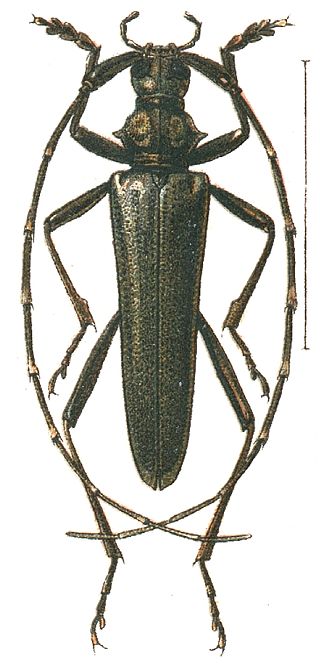
The Disteniidae are a small family of beetles in the superfamily Chrysomeloidea, traditionally treated as a group within the Cerambycidae.
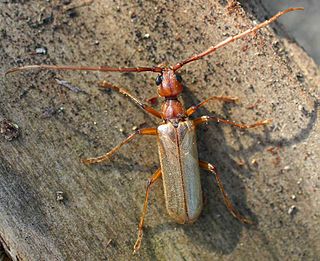
The Vesperidae are a small family of beetles, normally classified within the family Cerambycidae, of heterogeneous aspect but all characterised by larval stages related to roots of herbaceous plants or trees

Dorcasominae is a subfamily of the longhorn beetle family (Cerambycidae).

Sternidius is a genus of flat-faced longhorns in the family of beetles known as Cerambycidae. There are at least 20 described species in Sternidius.
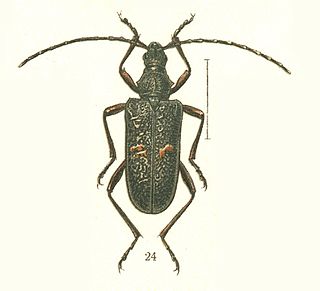
Sachalinobia is a genus of flower longhorns in the beetle family Cerambycidae. There are at least two described species in Sachalinobia.

Bothriospila is a genus of beetles in the family Cerambycidae, and the type genus of the tribe Bothriospilini. It contains two species: the type, Bothriospila elegans, found in Brazil and Paraguay, and Bothriospila pulcherrima, found in Brazil. The latter was described as a new species from Brazil in 2012. Bothriospila was circumscribed in 1923 by Swedish entomologist Per Olof Christopher Aurivillius.
Ranqueles is a genus of beetles in the family Cerambycidae. The genus was circumscribed by French entomologist Pierre-Émile Gounelle in 1906, with the South American R. mus assigned as the type, and at that time, only species. It now contains the following species:

Eburia tetrastalacta is a species of beetle in the family Cerambycidae.

Mesechthistatus taniguchii is a species of beetle in the family Cerambycidae. It was described by Seki in 1944. It is found in Japan and in Jiangxi, China.
Phytoecia eugeniae is a species of beetle in the family Cerambycidae. It was described by Ganglbauer in 1884. It is known from Iran.

Tetropium is a genus of long-horned beetles in the family Cerambycidae. There are at least 20 described species in Tetropium.
Lahejia is a genus of leaf beetles in the subfamily Eumolpinae. It is known from Africa and Asia. It is related to Malegia.

Zonopterus is a genus of beetles in the family Cerambycidae. Like most members in the tribe Callichromatini, species in the genus are brightly coloured with bands across the elytra. Most species in the genus are restricted to Southeast Asia with one species occurring in the Western Ghats of South Asia which is closely related to the type species Zonopterus flavitarsis from the eastern Himalayas. The genus was named by Frederick William Hope using the Greek roots ζώνη for belt describing the insect as "belted winged".
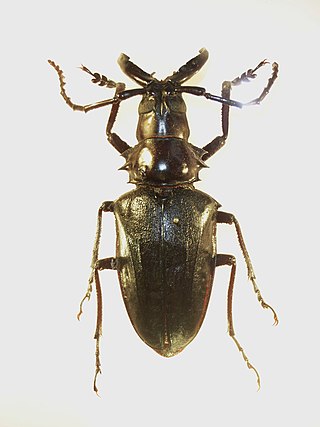
Dorysthenes walkeri is a species of longhorn beetles in the subfamily Prioninae. Records of occurrence are from Iran to Indo-China.

Pachylocerus corallinus is a species of beetle in the family Cerambycidae. It is found in southwestern India. It was first described and given its binomial name by Frederick William Hope who examined a specimen from the cabinet of Captain Thomas Smee of the Indian Navy who had obtained it from a prickly pear in the vicinity of "Omlecope Dawar". Specimens have been recorded from as far north as Bombay, south through Matheran, Goa, to Mangalore. In this genus, the eyes are divided. The antennae are short and do not reach past the middle of the elytra in the male and are even shorter in the female.

Neoplocaederus obesus, commonly known as Cashew stem borer or Red cocoon-making longhorn, is a species of longhorn beetle native to South Asian and South East Asian countries.

Clytocera is a genus of long-horned beetle in the tribe Clytini. The genus was erected in 1906 for the southern Indian species Clytocera chionospila by Charles Joseph Gahan. The genus was separated from Rhaphuma on the basis of raised and divergent antennal supports.

Priotyrannus is a genus of long-horned beetles in the subfamily Prioninae found in the Old World tropics within the Indo-Malayan Realm. Species in the genus include:

Oplatocera is a genus of longhorn beetle with about ten species distributed in Asia. The genus is identified by the wide mandibles without teeth on their inner edge with the base being hairy. The antenna base has a thick joint and the third segment is longer than the fourth and the segments shorten from base to tip. The third to seventh antennal segments have spines on the outer margins in some species.
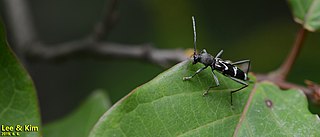
Rhaphuma is a genus of typical longhorn beetles in the family Cerambycidae. There are more than 200 described species in Rhaphuma.















